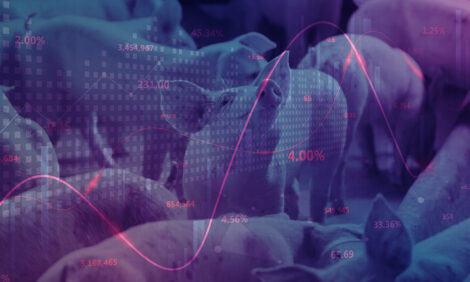



Effects of diet complexity and replacement of soybean meal on growth performance of weanling pigs
By E.C. Baudon, J.D. Hancock, and N. Llanes, Kansas State University Swine Day 2003. In this article, a total of 192 pigs (avg initial BW of 13.9 lb and avg initial age of 21 d) were used to determine the effects of complex diet formulations (with plasma protein and whey) in nursery diets with wheat gluten used to replace soybean meal.
Summary
Treatments were arranged as a 2 x 2 factorial, with main effects of diet complexity
(no animal plasma and 10% dried whey vs 7% animal plasma and 20% dried
whey) and soybean meal (25% vs none).
For d 0 to 14, the complex diet formulations increased
ADG while replacement of the soybean
meal with wheat gluten decreased ADG
(P<0.001). Efficiency of gain was improved
by 7% when plasma and whey were increased
in the formulations (P<0.04) but not affected
by deletion of soybean meal (P=0.15 or
greater).
When all the pigs were changed to a
common Phase 2 diet (with soybean meal and
without plasma) for d 14 to 28, ADG and
ADFI were less for those pigs fed the more
complex formulations during the first 14 d of
the experiment (P<0.002).
Overall (d 0 to 28),
pigs fed diets with soybean meal for d 0 to 14
had greater ADG and ADFI, and pigs fed the
diets with plasma and 20% whey had better
feed/gain (P<0.007). In conclusion, complex
formulations (i.e., with 7% plasma and 20%
whey) for d 0 to 14 improved growth performance
regardless of the absence or presence
of soybean meal, and using wheat gluten
to rid the Phase 1 diets of soybean meal was
of no benefit.
Introduction
Research reports from Kansas State University indicate few (if any) problems with 20 to 30% soybean meal in Phase 1 nursery diets with complex formulations (e.g., with high inclusions of animal plasma, whey powder and fishmeal). Yet, anecdotal reports from Latin America, where milk products and animal plasma are too expensive or not available, suggest limiting inclusion of soybean meal to 10% or less in Phase 1 diets. Therefore we conducted an experiment to determine the effects of complex diet formulations on the response of weanling pigs to deletion of soybean meal in Phase 1 diets.
Procedures

A total of 192 pigs (avg initial BW of 13.9
lb and avg initial age of 21 d) were used in the
28-d growth assay. The pigs were sorted by
sex, blocked by weight, and allotted to pens
(six pigs per pen and eight pens per treatments).
The pens were 3.5-ft × 5-ft with a
self-feeder and nipple waterer to allow ad libitum
consumption of feed and water. For d 0
to 14, dietary treatments were arranged as a 2
x 2 factorial with main effect of diet complexity
(no plasma and 10% dried whey vs 7%
plasma and 20% dried whey) and inclusion of
SBM (25% vs none).
Fishmeal was increased
in the simple diet formulations to replace the
protein from plasma, and whey powder and
wheat gluten were increased primarily in the
formulations for the diets without soybean
meal. All diets for d 0 to 14 had 1.8% lysine,
0.9% Ca, and 0.8% P (Table 1). For d 14 to
28, all pigs were given the same corn-soybean
meal based diet (Table 2) with 1.5% lysine,
0.8% Ca, and 0.7% P.
To begin the experiment and on d 14 and
28, the pigs and feeders were weighed to allow
calculation of ADG, ADFI, and F/G. All
data were analyzed as a randomized complete
block design with a 2 × 2 factorial arrangement
of treatments using the PROC MIXED
procedure of SAS.

Results and Discussion
For d 0 to 14 (Table 3), there were no interactions
among complexity of diet formulation
and removal of the soybean meal (P=0.15
or greater). However, the complex diet formulations
(with 7% plasma and 20% dried
whey) increased ADG by 14%, ADFI by 19%
(P<0.001), and F/G by 7% (P<0.04). Replacing
the soybean meal decreased ADG by 17%
and ADFI by 22%. So, the diets with plasma
protein and more whey powder increased
growth performance, and replacing soybean
meal was of no benefit, regardless of diet
complexity.
For d 14 to 28, pigs previously fed the
complex formulations (for d 0 to 14) had
lower ADG (P<0.002) and ADFI (P<0.003)
than pigs initially fed the simpler diet formulations.
This response suggested that having to
deal with the simple diets for d 0 to 14 better
prepared the piglets for the transition to the
simple Phase 2 formulation. Finally, there was
an interaction for F/G among diet complexity
and soybean meal inclusion (P<0.03) with replacement
of the soybean meal having a negative
effect when pigs were fed the simple diets
in Phase 1 and a positive effect in pigs fed the
more complex formulations in Phase 1.
Overall (d 0 to 28), F/G was 3% better
(P<0.007) when pigs were fed the complex
formulations for d 0 to 14. Also, there was
6% greater ADG and ADFI for pigs fed diets
with soybean meal in Phase 1 (P<0.003). So,
even though the pigs fed simpler diets for the
first 14 d postweaning made the transition to
the Phase 2 diets more readily, they never
overcame their sharply lower performance for
that first 14 d after weaning.
In conclusion, the more complex formulations
improved growth performance for d 0 to
14 of the nursery phase. There was some difficulty
with transition to the simple Phase 2
diet for pigs fed the more complex formulations
in Phase 1, with lower ADG and ADFI,
but that short lag in performance was outweighed
by the better early growth for pigs
given the more complex diet for d 0 to 14.
Finally, we were not able to demonstrate a
benefit when wheat gluten was used to replace
soybean meal in Phase 1 diets.

Source - Kansas State University Swine Day 2003 - Article Published here October 2004








